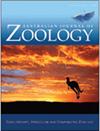Understanding Australia’s unique hopping species: a comparative review of the musculoskeletal system and locomotor biomechanics in Macropodoidea
IF 1
4区 生物学
Q3 ZOOLOGY
引用次数: 2
Abstract
Abstract. Kangaroos and other macropodoids stand out among mammals for their unusual hopping locomotion and body shape. This review examines the scaling of hind- and forelimb bones, and the primary ankle extensor muscles and tendons. We find that the scaling of the musculoskeletal system is sensitive to the phylogenetic context. Tibia length increases with positive allometry among most macropodoids, but negative allometry in eastern grey kangaroos and isometry in red kangaroos. Femur length decreases with stronger negative allometry in eastern grey and red kangaroos than among other macropodoids. Muscle masses scale with negative allometry in western grey kangaroos and with isometry in red kangaroos, compared to positive allometry in other macropodoids. We further summarise the work on the hopping gait, energetics in macropodoids, and stresses in the musculoskeletal system in an evolutionary context, to determine what trade-offs may limit locomotor performance in macropodoids. When large kangaroos hop, they do not increase oxygen consumption with speed, unlike most mammals, including small hopping species. We conclude that there is not enough information to isolate the biomechanical factors that make large kangaroos so energy efficient. We identify key areas for further research to fill these gaps.了解澳大利亚独特的跳跃物种:大足总纲肌肉骨骼系统和运动生物力学的比较综述
摘要袋鼠和其他大足类动物因其不同寻常的跳跃运动和体型而在哺乳动物中脱颖而出。本文综述了后肢和前肢骨骼的鳞屑,以及主要的踝关节伸肌和肌腱。我们发现,肌肉骨骼系统的尺度是敏感的系统发育背景。胫骨长度在大多数大足类动物中呈正异速增长,但在东部灰袋鼠中呈负异速增长,在红袋鼠中呈等速增长。东部灰袋鼠和红袋鼠的股骨长度比其他大足类动物更短,负异速发育更强。与其他大足类动物的正异速测量相比,西部灰袋鼠的肌肉质量呈负异速测量,红袋鼠的肌肉质量呈等距测量。我们进一步总结了在进化背景下大足类动物跳跃步态、能量学和肌肉骨骼系统压力方面的工作,以确定哪些权衡可能限制大足类动物的运动表现。当大袋鼠跳跃时,它们不像大多数哺乳动物,包括小型跳跃物种那样,以速度增加氧气消耗。我们的结论是,没有足够的信息来分离出使大型袋鼠如此节能的生物力学因素。我们确定了进一步研究的关键领域,以填补这些空白。
本文章由计算机程序翻译,如有差异,请以英文原文为准。
求助全文
约1分钟内获得全文
求助全文
来源期刊
CiteScore
2.40
自引率
0.00%
发文量
12
审稿时长
>12 weeks
期刊介绍:
Australian Journal of Zoology is an international journal publishing contributions on evolutionary, molecular and comparative zoology. The journal focuses on Australasian fauna but also includes high-quality research from any region that has broader practical or theoretical relevance or that demonstrates a conceptual advance to any aspect of zoology. Subject areas include, but are not limited to: anatomy, physiology, molecular biology, genetics, reproductive biology, developmental biology, parasitology, morphology, behaviour, ecology, zoogeography, systematics and evolution.
Australian Journal of Zoology is a valuable resource for professional zoologists, research scientists, resource managers, environmental consultants, students and amateurs interested in any aspect of the scientific study of animals.
Australian Journal of Zoology is published with the endorsement of the Commonwealth Scientific and Industrial Research Organisation (CSIRO) and the Australian Academy of Science.

 求助内容:
求助内容: 应助结果提醒方式:
应助结果提醒方式:


